Working on the Roubo Leg: the old fashioned way (kinda)
In the upcoming weeks I’ll be highlighting some of my work on the Roubo in my podcast. The topic of this podcast will be an introduction to this project as well as highlights on building the top. I am doing video for this as I feel it is the most important part of the bench. I lead with this disclaimer now so that none of you wonder, “what happened to the top?” as I launch into the topic of this post: the legs.
In one of my earlier posts I sung the praises of my little 6 inch Grizzly jointer and it’s ability to flatten 9-11 foot boards. I think the truth of the matter is that the boards are so long that the imperfections were not obvious. Don’t get me wrong, I am still getting a pretty flat face, but after starting to laminate the boards, I realize just how much hand planing is required to get them to mate correctly without 900 lbs of clamping pressure.
I was sad to realize that I was running into some of the similar problems with the shorter leg parts. I have cut 16 parts for the legs all under 36 inches long and in the neighborhood of 5 inches wide. 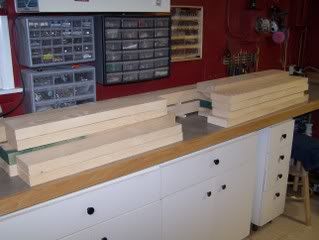
This is a board length that can be handled easily by any jointer out there. That is if your jointer is tuned properly. I think that my tables have come out of alignment because no matter what I do I cannot get a flat face. Sure there is technique to jointing, but it is mainly to keep yourself safe. If the jointer is properly set up and tuned you should get great results with very little contortions on your part. I used a gift card to Lee Valley and bought myself one of their 58 inch precision straight edges. Something I have wanted for a while and was waiting for the right moment. For good measure I got some feeler gauges too. The table realignment will be a topic for another day.
All of this preamble is leading me to a point. While I am waiting for the straight edge to arrive, I didn’t want to sit on my hands, so I broke out the 24 inch straight edge, jack plane, jointer plane, and starting prepping my rough boards for the legs. I figured if I could get one edge flat or at least stable, I could use my thickness planer to prep the opposite side.
Here is a shot of one of the boards in it’s rough form.

Using my straight edge and by fiddling with the board on my flat bench top I determined which side was the concave side and also where the twist was in the board. Using a pencil I highlighted the corner causing the twist problem.
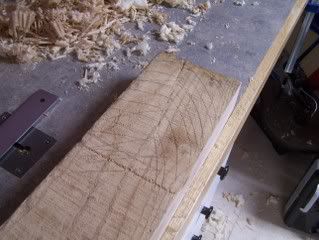
And then I went to work with my jack plane set to a medium depth cut and the mouth adjusted wide to allow for thick shaving. I don’t have a scrub plane so this was the best solution. I started planing across the grain. (a workholding nightmare when you don’t have a bench; catch 22 I know) and this levelled the cup and the bow at the same time. I spent a little more time on the highlighted corner to kill the twist.

With this kind of work you get these very interesting cross grain shavings.
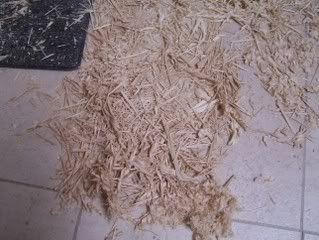
Here is a shot of the hand jointed side of the board. You’ll see that I didn’t hit the complete board but only enough to get the board to lie flat and stable.
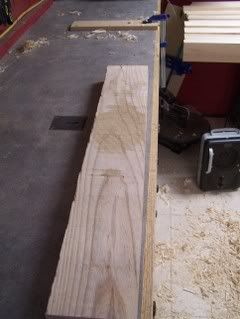
I then ran it through the thickness planer referencing the hand planed side down on the bed. Here is what I got out on the other side.
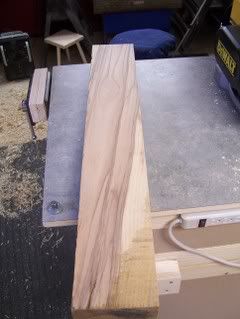
You can see that this worked great to almost completely flatten the opposing side with one 32nd inch deep pass. Another pass and I had that side completely flat. Just a simple flip of the board and the other side was pretty too. I then followed it up with a few more passes to bring the board to the final 1 1/4″ thickness. Actually I kept it a hair thicker to allow for some trimming once I have laminated the boards into the 5 x 5 inch legs.
At this stage getting the edges flat and parallel is not really important as I will be face laminating 4 boards together to make the final leg. Once those are glued I will then joint and thickness from there. Seeing as I was on a roll however, I thought I would give a few edges a try. These leg parts were all ripped to approximate size from a wider board so I had at least one relatively flat edge from the table saw. Starting there on that edge I went to work with the jointer plane to flatten and square the edge. It takes a little doing to get it perfectly square but check often and apply pressure with the plane where needed to control the cut.
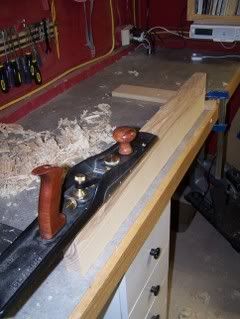
Once I have flattened the first edge, I ran it through the planer to true up the other edge. A lot of people never think to use their planer to do the edges, but I find it works great in thicker stock where you are not worried about tipping.
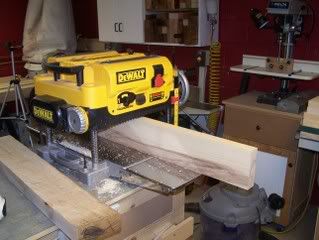
This is hard work and no doubt I could have blown through this in half the time with the power jointer, but isn’t a workbench build supposed to hone your fundamental skills? I am glad the machine let me down in this instance because this stack of boards has taught me a lot.
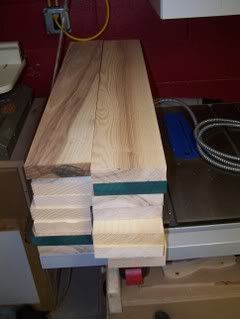
Ain’t they purty!
PS: keep in mind that all of this wood was kiln dried and has been acclimating to my shop for over 6 months. While I am not at finished thickness I am very close. I feel comfortable doing this as the wood is sitting at 7% moisture and is very stable. Were the wood wetter I would leave time in between planing for more drying time.


